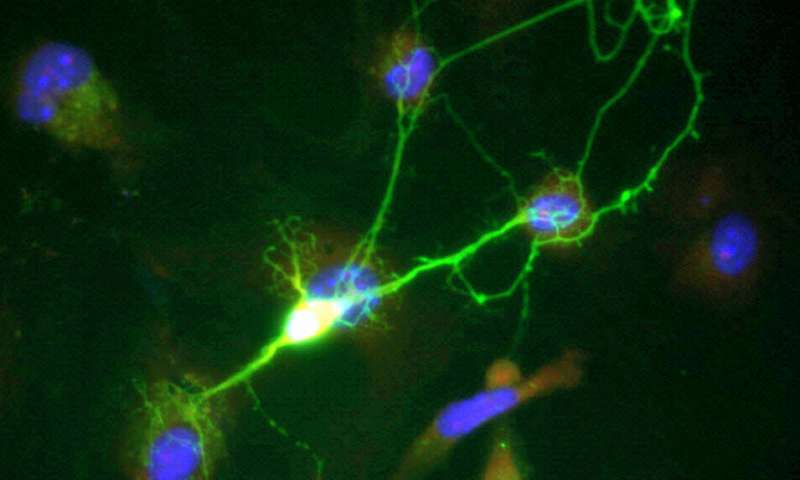This article has been reviewed according to Science X's editorial process and policies. Editors have highlighted the following attributes while ensuring the content's credibility:
fact-checked
peer-reviewed publication
trusted source
proofread
Morphine tolerance found to result from Tiam1-mediated maladaptive plasticity in spinal neurons

Morphine and other opioids are vital to treat severe and chronic pain. However, they have two problems—prolonged use creates morphine tolerance, where ever-increasing doses are needed for the same pain relief, and paradoxically, prolonged use also can create an extreme sensitivity to pain, called hyperalgesia.
Researchers at the University of Alabama at Birmingham and Baylor College of Medicine, Houston, Texas, now have shown that blocking the activity of an enzyme called Tiam1 in certain spinal neurons abrogates morphine tolerance and hyperalgesia in a mouse model. Their work highlights Tiam1-mediated maladaptive neural plasticity as a promising therapeutic target to reduce tolerance and prolong the usefulness of morphine for pain relief.
"Understanding the mechanisms underlying tolerance and hyperalgesia is essential to enhance morphine's utility in chronic pain management," said Lingyong Li, Ph.D., an associate professor at the UAB Department of Anesthesiology and Perioperative Medicine.
The study, published in the journal Brain, was led by Li and co-corresponding author Kimberley Tolias, Ph.D., a professor at Baylor College of Medicine.
In the mouse model, seven days of repeated morphine treatments induce tolerance and hyperalgesia. Notably, tolerance and hyperalgesia continue at least one week after morphine withdrawal, suggesting that the sustained morphine treatment triggered plasticity in nerve function in the spinal dorsal horn, alongside plasticity in the actual structure of the neuron.
The spinal dorsal horn receives pain messages from peripheral areas of the body and relays them to the brain, or it can evoke a rapid reflex action, like jerking a hand from the touch of a hot stove burner.
Using a mouse model of neuropathic pain, Li and Tolias reported last year in the journal Neuron that Tiam1 acts to coordinate synaptic structural and functional plasticity in spinal dorsal horn neurons.
Furthermore, targeting spinal Tiam1 with anti-sense oligonucleotides injected into the cerebrospinal fluid effectively alleviated neuropathic pain hypersensitivity. Thus, for the current study, they hypothesized that Tiam1-mediated maladaptive plasticity also contributes to morphine tolerance and hyperalgesia.
They first found that prolonged morphine treatment markedly increased the amount of activated Tiam1 in spinal dorsal horn neurons and that Tiam1 remained activated after the seven-day morphine treatment ended. Furthermore, a global Tiam1 deletion in mice or a conditional Tiam1 deletion from spinal dorsal horn neurons or from dorsal root ganglion neurons in the spine prevented the development of morphine anti-pain tolerance and hyperalgesia.
Li, Tolias, and colleagues also showed that inhibiting Tiam1 signaling with the pharmacological inhibitor NSC23766 prevented the development of morphine anti-pain tolerance, known as anti-nociceptive tolerance. That inhibition also prevented development of hyperalgesia. Nociception is the neural feedback from skin to the central nervous system to detect painful and damaging stimuli.
The researchers found giving the mice NSC23766 at the same time as the prolonged morphine treatments blocked the development of morphine tolerance and hyperalgesia dose-dependently. Importantly, when NSC23766 treatment started only after the seven days of morphine treatment had finished, NSC23766 was able to reverse established tolerance and hyperalgesia.
Tiam1 is known to modulate the activity of other proteins that help build or unbuild the cytoskeletons of cells, and the building of cytoskeleton actin filaments is part of dendritic spine creation. Dendrites are tree-like appendages attached to the body of a neuron that receives communications from other neurons; dendritic spines are thorn-like projections from the branches. Each spine can receive input from a single axon, increasing the number of contacts between neurons.
Besides the Neuron study on neuropathic pain in 2023, Li and Tolias, in a 2022 Journal of Clinical Investigation study, found that the depression that is induced by chronic pain leads to an activated Tiam1 in anterior cingulate cortex pyramidal neurons of the brain, resulting in an increased number of spines on the neural dendrites.
In the current study of morphine tolerance, the investigators found similar dendritic spine morphological changes. Prolonged morphine treatment increased the density of dendritic spines in wide dynamic range neurons in wildtype mice, and this was accompanied by evidence of actin filament polymerization in the neurons. In contrast, Tiam1-knockout mice did not show an increase in the density of dendritic spines after prolonged morphine treatment.
On neural dendrites, the NMDA receptor is a receptor of glutamate, a primary excitatory neurotransmitter. Other researchers have shown that NMDAR-mediated central sensitization in the spinal dorsal horn has been implicated in morphine tolerance and hyperalgesia. Li and Tolias found that Tiam1 is required for these NMDAR changes.
In wild-type controls, the seven-day morphine treatment increased the levels of two synaptic NMDAR subunits, while those synaptic NMDAR subunit levels were unaltered after seven-day morphine treatment in Tiam1-knockout mice.
Similarly, electrophysiological recordings of dorsal horn neurons in the wild-type mice revealed that seven-day morphine treatment significantly increased postsynaptic NMDAR currents elicited by puff application of NMDA, an increase not seen in Tiam1-knockout mice.
Finally, the researchers showed that combination therapy of morphine and NSC23766 delivered long-lasting anti-nociception without the development of tolerance for chronic pain management.
"Taken together, our pharmacological results highlight the potential benefit of inhibiting Tiam1 signaling to reduce tolerance and prolong morphine use in chronic pain management," Li said.
More information: Changqun Yao et al, Tiam1-mediated maladaptive plasticity underlying morphine tolerance and hyperalgesia, Brain (2024). DOI: 10.1093/brain/awae106



















